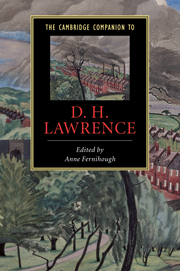Book contents
- Frontmatter
- Introduction
- Part 1 Texts
- 1 Ideas, histories, generations and beliefs: the early novels to Sons and Lovers
- 2 Narrating sexuality: The Rainbow
- 3 Sex and the nation: ‘The Prussian Officer’ and Women in Love
- 4 Decolonising imagination: Lawrence in the 1920s
- 5 Work and selfhood in Lady Chatterley’s Lover
- 6 Lawrence’s tales
- 7 Lawrence’s poetry
- 8 Lawrence as dramatist
- Part 2 Contexts and critical issues
- Guide to further reading
- Index
6 - Lawrence’s tales
from Part 1 - Texts
Published online by Cambridge University Press: 28 May 2006
- Frontmatter
- Introduction
- Part 1 Texts
- 1 Ideas, histories, generations and beliefs: the early novels to Sons and Lovers
- 2 Narrating sexuality: The Rainbow
- 3 Sex and the nation: ‘The Prussian Officer’ and Women in Love
- 4 Decolonising imagination: Lawrence in the 1920s
- 5 Work and selfhood in Lady Chatterley’s Lover
- 6 Lawrence’s tales
- 7 Lawrence’s poetry
- 8 Lawrence as dramatist
- Part 2 Contexts and critical issues
- Guide to further reading
- Index
Summary
Lawrence wrote more than sixty tales. His first published work, ̒A Prelude̓, won the `most enjoyable Christmas' section of a local short-story competition in 1907. His last published work, a long tale entitled The Escaped Cock, appeared in 1929. In the intervening years he wrote stories in a wide variety of forms sketches and novellas, naturalistic tales, fables, apologues, satires and ghost stories. Many of these pieces were collected in the five volumes of stories published in his lifetime: The Prussian Officer and Other Stories (1914), England, My England (1922), The Ladybird, The Fox, and The Captain's Doll (1923), St. Mawr together with The Princess (1928) and The Woman Who Rode Away and Other Stories(1928). Most of the others appeared in three posthumous volumes: Love Among the Haystacks & Other Pieces (1930), The Lovely Lady (1933) and A Modern Lover (1934).
The remarkable achievement of this body of writing is often overshadowed by Lawrence's novels. Dozens of books have been written on the longer fiction but only a handful on the tales.1 The disparity reflects both the relative prestige of the genres and the terms on which the stories were produced. Lawrence himself often represented his tales as a way of making `running money' (i. 431) in effect, of subsidising the longer works which consumed his attention. The vogue for the short story in the early part of the century opened a reasonably lucrative market, and Lawrence managed to have stories placed in a range of English and American literary journals and magazines, among them Ford Madox Hueffer's English Review, the Nation & Athenaeum (for which Leonard Woolf was reviews editor), the Dial, the Metropolitan, the Century and, at the popular end of the market, Hutchinson's Story Magazine. If a particular tale was then reprinted in one of his collections, Lawrence would benefit from it twice. These financial possibilities of short fiction were always significant for Lawrence; early on they strengthened his resolve to break with school-teaching and later they helped him keep financially afloat through a creative life on four continents.
- Type
- Chapter
- Information
- The Cambridge Companion to D. H. Lawrence , pp. 103 - 118Publisher: Cambridge University PressPrint publication year: 2001
- 1
- Cited by



